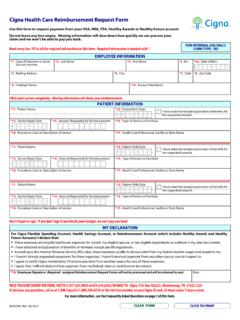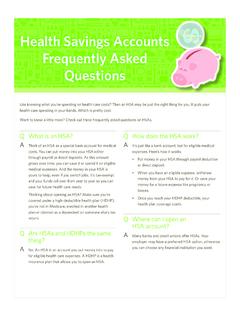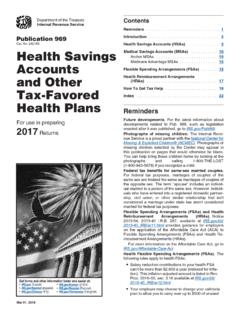Transcription of Consumer-Driven Health Care: What Is It, and What Does It ...
1 COMPENSATION AND WORKING CONDITIONS. BUREAU OF LABOR STATISTICS. Consumer-Driven Health Care: What Is It, and What Does It Mean for Employees and Employers? by Song G. Yi Bureau of Labor Statistics Originally Posted: October 25, 2010. Some employers are considering the switch to Consumer-Driven Health plans (CDHPs) in order to reduce the cost of providing Health insurance benefits to their employees. Because CDHPs generally have lower premiums, they might be a popular choice for some employees. Employers and employees will need to carefully weigh the costs and benefits of CDHPs compared with more traditional Health insurance plans before deciding which type of plan to use.
2 The cost to employers of providing Health insurance to their employees has been rising for Estimates from the National Compensation Survey (NCS) indicate that the average cost for the private employer to provide Health care insurance has risen from $ per hour worked in March 1999 to $ per hour worked in March 2009, a change from percent to percent of total Chart 1 displays the rising cost for the private employers. Interestingly, the costs to employees have increased as well. NCS estimates indicate that the average medical plan monthly flat-rate premium paid by private industry workers in single and family coverage has increased from $ (single) and $ (family) in 2004 to $ (single) and $ (family) in Even though the cost for both employer and employee has increased, the proportion of cost for the employer and employee has remained similar.
3 In 2003, private employers share of the premium for single coverage reflected 82 percent of the total premium, whereas the employees were responsible for the remaining 18 percent. In 2009, the employers share for single coverage was 80 percent compared with 20 percent for the employees share. The share for family coverage was at 70 percent for the employer and 30 percent for the employee in 2003 and in Page 1. COMPENSATION AND WORKING CONDITIONS. BUREAU OF LABOR STATISTICS. With the rise in Health care costs, what options are available for employers and employees to lower their costs each month? Some employers may have stopped offering Health insurance as a benefit altogether.
4 Some employees may have opted not to enroll in the Health plan, and others might have lost coverage when their employers went out of business during the recent recession (although coverage rates have remained fairly steady in recent years).5 These options are extreme, however, because they result in no coverage, which puts employees and their families in a position of financial risk should they need urgent medical care. Yet, there are some available alternatives for employers and employees that would help to trim their One of these alternatives is the Consumer-Driven Health plan. Consumer-Driven Health Plans The combination of a pretax payment account with a high-deductible Health plan is what is commonly referred to as a Consumer-Driven Health plan (CDHP).
5 7 In terms of payment methods, CDHPs are often referred to as three-tier payment systems, consisting of a savings account , out-of-pocket payments, and an insurance The first tier is a pretax account that allows employees to pay for services using pretax dollars. The account may be funded by the employer or the employee, depending on the type of account . The funds from this account can be used to satisfy the insurance plan deductible. The second tier is the difference, or the coverage gap, between the amount of money in the individuals pretax account and the deductible. The amount that is not covered by the pretax account must be covered by the insured.
6 If Health care expenses exceed the deductible amount, then the third tier, the high-deductible Health insurance plan, kicks in. Once this happens, everything behaves like a traditional Health plan. The insured pays a coinsurance amount for benefits until an out-of-pocket maximum is reached. Once the out-of-pocket maximum is reached, the high-deductible Health plan covers all costs for the remainder of the year. Subsequent sections of this article describe the various types of pretax accounts and how they are used, most of the time in conjunction with a high-deductible Health plan, as a low-cost substitute for a traditional medical care plan.
7 High-deductible Health Plans High-deductible Health plans (HDHPs) are Health plans with higher annual deductibles (the amount the insured must pay in medical costs before receiving coverage) and a higher annual out-of-pocket maximum (the amount that the insured pays before being fully covered for costs) than the typical traditional plan. One can view these plans as catastrophic coverage plans; HDHPs guard against major medical cost. Estimates from the National Compensation SurveyBenefits show that 15. percent of private sector workers participate in a high-deductible Health plan. NCS benefits data also show that in 2009 the annual median deductible of a non-high-deductible Health plan in the private sector was $400 per individual coverage, while it was $1,600 for In turn, HDHPs have lower premiums compared with traditional Health The lower premiums translate into lower costs for both the employer and the employee.
8 HDHPs share another important feature that distinguishes them from traditional healthcare plans; a person must be enrolled in an HDHP to open a Health savings account (HSA) or an Archer medical savings account (MSA). The HDHP and the HSA. or MSA work together to provide employees with tax-free savings earmarked for medical expenses. There are other types of pretax accounts that do not require enrollment in an HDHP that can be used to pay for medical care. There are various pretax accounts used to pay for medical care; however, each account has some feature that distinguishes it from the others. (See Exhibit 1.). Health Savings Accounts Health savings accounts (HSAs) allow various advantages for the account owners.
9 For example, the employer or the employee may fund pretax dollars into this account up to the limit set by the Internal Revenue Any unused amount in this account will not be lost at the end of the year. Rather, the unused amounts will rollover to the next year without a penalty. Also, the rules for HSAs allow the money in these accounts to be used for retirement income, subject to regular income tax if the money is withdrawn after age 65. Before 65, there will be an additional 10-percent tax penalty. Participants may even elect to invest in stocks or other financial instruments using funds from this account . The same types of Page 2.
10 COMPENSATION AND WORKING CONDITIONS. BUREAU OF LABOR STATISTICS. investments permitted for IRAs are allowed for HSAs. And as long as the money is withdrawn to pay medical expenses and not for retirement income, the interest or other earnings in this account are tax and penalty There are stringent requirements for opening an HSA. An individual must be enrolled in a qualified HDHP to enroll in an HSA. The Internal Revenue Service (IRS) has placed rules and guidelines for HDHPs to be qualified. The HDHP must meet the following requirements: as of 2009, the IRS defines an HDHP as a Health plan with a minimum yearly deductible of $1,150 for an individual and $2,300 for a family; and the annual maximum out-of-pocket expense cannot exceed $5,800 for an individual and $11,600 for a Archer Medical Savings Accounts Compared With Health Savings Accounts An Archer medical savings account (MSA) is similar to an HSA in that it must be paired with an HDHP.















